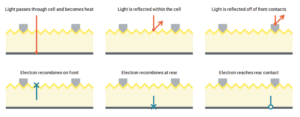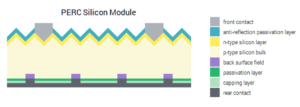What is PERC Solar Cell or Module? PERC stands for Passivated Emitter Rear Contact. PERC Solar Cell improves efficiency of the energy production by reducing losses. PERC solar cells and modules have grown in the market since last 10 years, but what is PERC cell technology and what are its advantages? In order to understand PERC cell technology, we need to understand first what are common inefficiencies generally found in standard silicon solar panels.
A standard solar panel cell contains two layers of silicon, commonly called “n-type” and “p-type” for their negative and positive charge behavior. A solar panel creates electricity when sunlight hits the solar cells, knocking electrons loose from the n-type layer as the p-type layer accepts them, creating an electric field.

Plain silicon solar cells have few losses or less efficiency. The first level of losses come from inefficiencies with capturing sunlight; sunlight can be reflected by the solar cell itself, blocked by wires, or sometimes go all the way through the cell and turn into heat, reducing cell efficiency. Another type of losses stem from the random motion of electrons knocked loose by the light; electrons may recombine with the silicon material on the front and back of the solar cell or sometimes miss going through the circuit.

Luckily, some of the efficiency losses can be mitigated by technology. For example, adding a front passivation layer stops front-side recombination and prevents some reflection. To prevent unwanted electron motion through the cell to the rear contact, you can add a back surface field layer or place all the wires on the back of the panel during production. The tricky inefficiency to manage is the conversion of sunlight to heat in the rear of the panel and back-side recombination.

PERC solar panels are built with PERC cells, which have an additional layer on the back of the traditional solar cells. This additional layer allows more sunlight to be captured and turned into electricity, making PERC cells more efficient than traditional cells. PERC modules are also able to mitigate rear recombination and prevent longer wavelengths from becoming heat that would impair the cell’s performance.
PERC technology has been around since 1989, but commercial implementations ran into trouble from increased light-induced degradation. With steady improvements over the years, however, PERC modules now have an efficiency that is 1 percentage point higher than that of standard modules. Given that a standard module typically has an efficiency of 20%, a system using PERC modules will generate about 5% more energy than a system using standard modules, all else being equal.

Therefore, even if roof space is not a major concern, it may be possible to save installation time and costs by using higher efficiency PERC modules. If a site takes 40 standard modules or 38 PERC modules to reach the desired annual production, you’re able to reduce the amount of racking, wiring, and MLPE devices needed to connect everything together.
PERC solar modules are structurally fairly similar to other silicon modules on the market, which is a distinct advantage for manufacturers. Even though there is some added cost to produce the new passivation and rear contact capping layers, panel producers are able to largely reuse existing production equipment. Based on cost reports from NREL and PV Magazine, PERC modules cost about the same, per watt, to manufacture as traditional silicon panels. PERC modules may cost slightly more than traditional ones, but they have a slightly higher efficiency and power rating.
